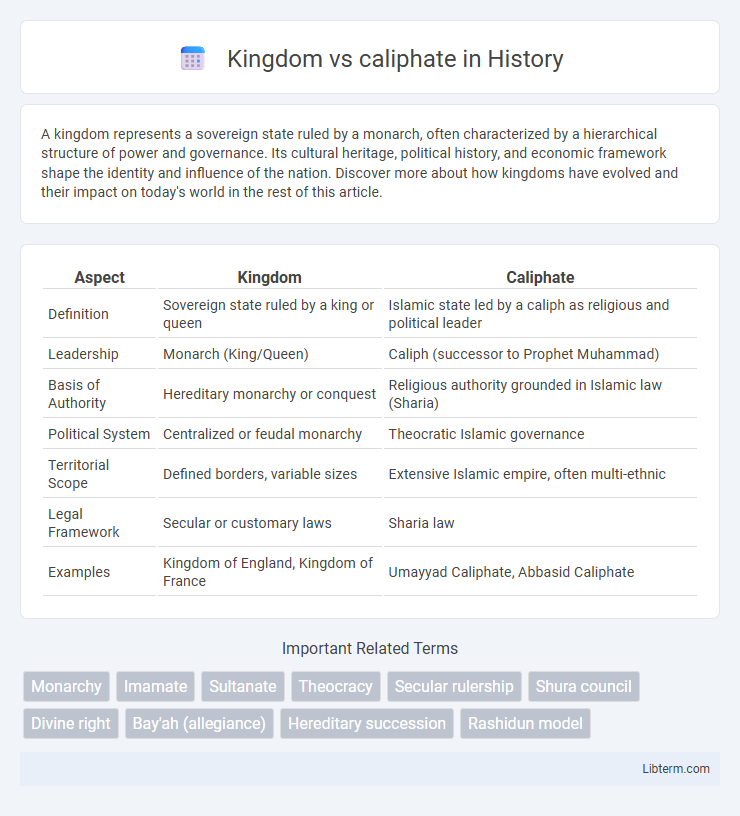A kingdom represents a sovereign state ruled by a monarch, often characterized by a hierarchical structure of power and governance. Its cultural heritage, political history, and economic framework shape the identity and influence of the nation. Discover more about how kingdoms have evolved and their impact on today's world in the rest of this article.
Table of Comparison
| Aspect | Kingdom | Caliphate |
|---|---|---|
| Definition | Sovereign state ruled by a king or queen | Islamic state led by a caliph as religious and political leader |
| Leadership | Monarch (King/Queen) | Caliph (successor to Prophet Muhammad) |
| Basis of Authority | Hereditary monarchy or conquest | Religious authority grounded in Islamic law (Sharia) |
| Political System | Centralized or feudal monarchy | Theocratic Islamic governance |
| Territorial Scope | Defined borders, variable sizes | Extensive Islamic empire, often multi-ethnic |
| Legal Framework | Secular or customary laws | Sharia law |
| Examples | Kingdom of England, Kingdom of France | Umayyad Caliphate, Abbasid Caliphate |
Definition and Origins of Kingdoms
A kingdom is a form of governance led by a monarch, often hereditary, whose authority is typically centralized within a defined territory historically rooted in feudal systems. The origins of kingdoms trace back to ancient civilizations such as Mesopotamia and Egypt, where rulers established dynastic rule over city-states and large regions. Kingdoms are characterized by structured hierarchies, codified laws, and traditions that reinforce the monarch's sovereignty.
Historical Evolution of Caliphates
The historical evolution of caliphates began with the Rashidun Caliphate (632-661 CE), recognized for uniting the Arabian Peninsula and expanding Islamic governance under the first four caliphs following Prophet Muhammad's death. This was succeeded by the Umayyad Caliphate (661-750 CE), marking a vast territorial expansion across North Africa, the Iberian Peninsula, and parts of Asia, characterized by a hereditary monarchy unlike the earlier elective leadership. The Abbasid Caliphate (750-1258 CE) centralized governance in Baghdad, fostering a golden age of Islamic culture, science, and law, diminishing political power but preserving religious authority amidst the rising influence of sultanates and kingdoms.
Governance Structures: Monarchy vs. Caliphate
Kingdoms operate under a monarchy where power is centralized in a king or queen, often inherited through a royal family lineage, reinforcing a hierarchical and dynastic governance structure. Caliphates function as Islamic theocracies led by a caliph, who holds both religious and political authority derived from Islamic law (Sharia), emphasizing a governance system rooted in religious legitimacy. The monarchy prioritizes hereditary succession and sovereign command, whereas the caliphate integrates spiritual leadership with administrative power, shaping governance through religious principles and community consensus.
Legitimacy and Succession Practices
Kingdoms typically derive legitimacy through hereditary monarchy, where succession follows established dynastic lines often based on primogeniture or appointment by the reigning monarch. Caliphates claim religious authority as the primary source of legitimacy, with succession practices rooted in Islamic principles, including election by a council (shura) or designation by the previous caliph, emphasizing spiritual and political leadership. The differing foundations of legitimacy influence governance structures, with kingdoms focusing on bloodline continuity and caliphates prioritizing religious endorsement and consensus among the Muslim community.
Religious Foundations and Authority
Kingdoms often derive authority from hereditary royal lineage and secular governance structures, while caliphates base legitimacy on religious foundations tied to Islamic law and the leadership of the Muslim community (Ummah). Caliphs are considered both political and spiritual leaders, embodying the role of religious authority sanctioned by the Quran and Hadith, unlike kings whose power is typically legitimized through tradition and conquest. The caliphate's authority is intrinsically intertwined with the implementation of Sharia law, whereas kingdoms may uphold diverse or secular legal systems.
Territorial Expansion and Political Influence
Kingdoms typically expanded through hereditary rule and military conquest, establishing centralized monarchies with defined borders and dynastic legitimacy. Caliphates extended their territorial reach by uniting diverse Muslim communities under religious authority, combining spiritual leadership with political governance to influence vast regions across Asia, Africa, and Europe. The political influence of kingdoms often centered on sovereign rule and feudal systems, whereas caliphates integrated religious law with state administration, shaping legal and cultural frameworks within their domains.
Social Organization and Legal Frameworks
Kingdoms typically feature a hierarchical social organization centered around a monarchy, where nobility and hereditary titles play key roles in societal structure. Legal frameworks in kingdoms often rely on codified laws merged with customary practices, with the king or queen serving as the ultimate judicial authority. Caliphates, by contrast, organize society around Islamic principles, emphasizing the ummah (community of believers) with religious scholars and judges (qadis) interpreting Sharia law as the foundation of legal and social order.
Economic Systems: Resource Control and Taxation
Kingdoms traditionally centralized resource control through monarchic estates, often imposing fixed taxes on land and production to sustain royal administrations and military forces. Caliphates implemented a more complex taxation system, including zakat (a religious alms tax) and jizya (a tax on non-Muslims), facilitating wealth redistribution and economic integration across diverse populations under Islamic law. Both systems relied heavily on controlling agricultural outputs and trade routes to maintain economic stability and institutional power.
Decline and Transformation Over Time
Kingdoms often experienced decline due to internal power struggles and economic instability, leading to fragmentation or conquest by emerging powers. Caliphates faced transformation through shifts in religious authority and political decentralization, particularly after the Abbasid era when regional dynasties gained autonomy. Both political entities evolved over time by adapting administrative structures and integrating diverse cultures to maintain influence amid changing geopolitical landscapes.
Modern Legacy: Impact on Contemporary States
Kingdoms have shaped modern nation-states by establishing hereditary monarchies that influence political stability and cultural identity, as seen in countries like Saudi Arabia and the United Kingdom. Caliphates, with their foundation in Islamic governance, continue to impact contemporary states through religious authority and legal frameworks, notably in countries such as Iran and Pakistan. The legacy of both systems affects modern governance structures, blending traditional leadership with modern state institutions.
Kingdom Infographic

 libterm.com
libterm.com